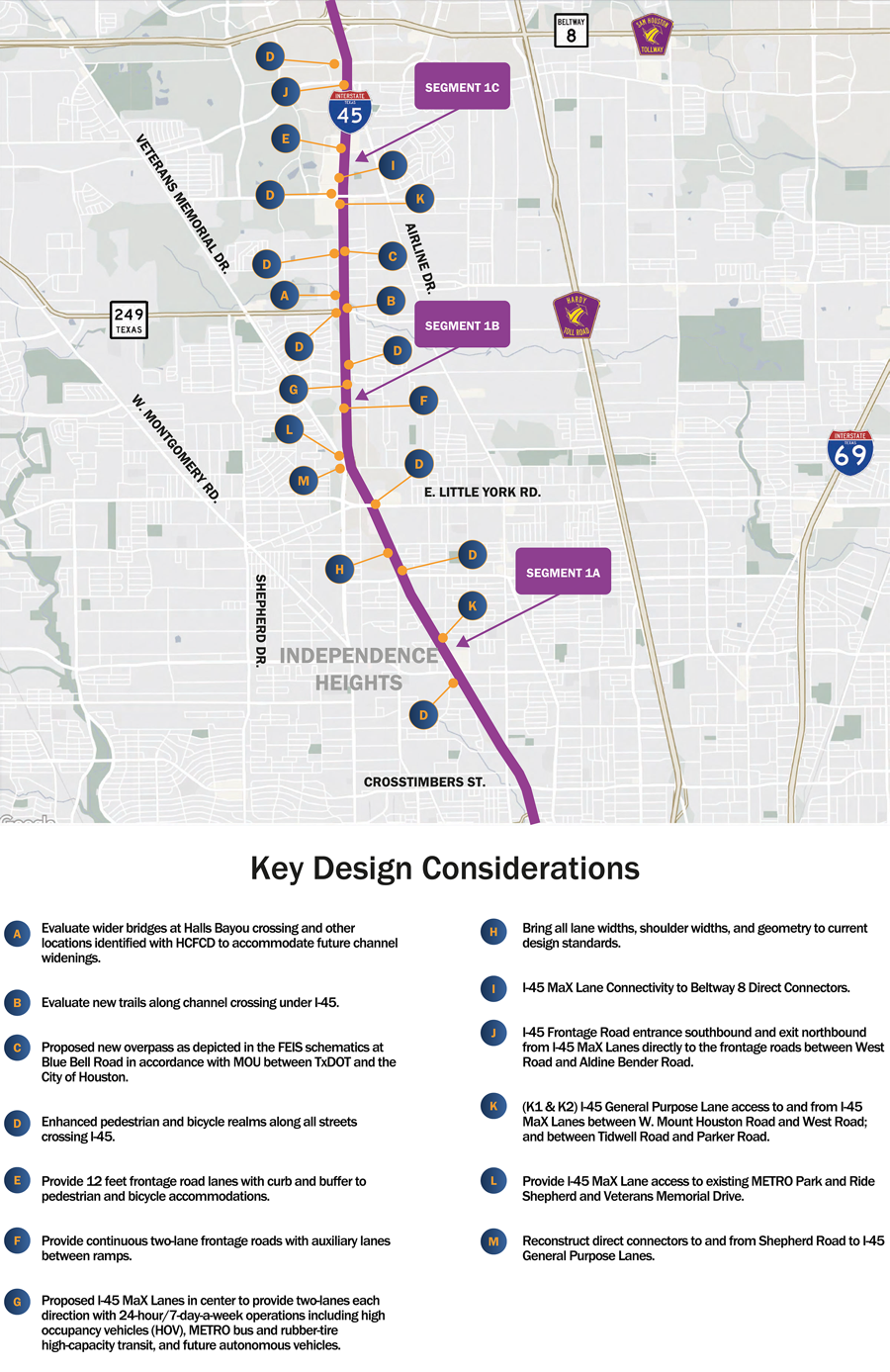Project segments
Key information
This segment will improve the I-45 between I-610 and Beltway 8 by widening the roadway to accommodate four lanes known as MaX lanes. The roadway would have:
- Four general purpose lanes in each direction with auxiliary lanes.
- Two MaX lane sin each direction operating 24/7 carrying HOV (high-occupancy vehicle) and METRO bus traffic.
- Addition of full-width shoulders
- Addition of bicycle/pedestrian features frontage roads
- Enhanced bicycle/pedestrian features on streets crossing I-45
Drainage in this segment would be improved for residents and businesses along I-45 with the addition of 11 new detention ponds including a joint regional detention pond facility with Harris County Flood Control District (HCFCD) on Halls Bayou just east of I-45, and with the use of increased storm sewer pipe sizes to provide in-line detention.
Construction phasing
Project Funding
Total Cost = $907,200,000
The Segment 1 projects are unfunded and are not actively in detailed design.
The project brings significant economic impacts to the Houston area as well as much needed safety improvements to one of the state's most congested highways. Some 92,000 direct jobs are being created with an additional 89,000 indirect jobs generated from this project. The overall statewide economic impact of NHHIP is estimated at $19.2 billion.
The future of transportation is changing and the infrastructure in the nation's fourth largest city needs to change with it. Parts of the I-45 corridor have not changed since being constructed over 50 years ago. The I-45 improvement project not only brings these highways up to current standards, but also prepares for the future by improving resiliency to weather events and providing safer more efficient travel that could accommodate the transition to electric and self-driving vehicles. And, importantly, it will increase the opportunity for transit and high-occupancy vehicles as a mode choice for those traveling along the I-45 North Houston corridor. Additionally, the neighborhoods in the project area will see many specific benefits beyond the economic and safety improvements.
Segment 1 project map
Potential footprint reduction
TxDOT remains committed to evaluating reasonable opportunities to reduce the project footprint in Segment 1 in ways that would not compromise the Purpose and Need of the project, as described in the Record of Decision (ROD).
As noted in the VRA, TxDOT agrees that requests to reduce the Project footprint should be evaluated with a focus on the following:
- Strengthening Houston's economy.
- Reducing flooding on and off the freeway.
- Making travel safer for all road users.
- Providing long-term capacity for all users of the roadway, including automobile, freight, and transit.
- Serving and preserving the neighborhoods along the corridor while enhancing connectivity between neighborhoods.
- Mitigating impacts to existing parks and open space while creating additional opportunity for open space.
- Ensuring accessible evacuation routes.
TxDOT agrees to use the least amount of right-of-way as allowed and defined by law, after evaluation of the project footprint. It is important to note that any proposals to reduce the Project footprint must not compromise safety, flooding mitigation, design standards, freight mobility and evacuation effectiveness.
ROW reduction methodology & guidelines
- Meets Project Purpose and Need as stated in Record of Decision (ROD)
- No design exceptions
- No reduction in capacity
- Consider braided ramps where applicable
- Braided ramps are where the exit/entrance ramps are in the same space, with one over the other
- No elevated MaX lanes
- Minimum 20-foot border width on frontage roads
- All frontage roads to include bicycle/pedestrian facilities (no on-street bicycle facilities allowed)
- Potential sound wall locations
- Evaluate different ramp envelopes (this is the distance needed between the inside edge of frontage road and general purpose lanes for the ramps)
Drainage
- Detention Pond locations were revised based on updated Drainage Studies completed in 2021.
- Revised pond locations shown on Segment 1 plan view.
Proposed typical section

Independence Heights
Independence Heights is the first African American municipality in Texas, and is in TxDOT's I-45 North Houston Highway Improvement Project (NHHIP) area.
Flood control
- Flooding risk reduced
TxDOT worked with HCFCD and the City of Houston to develop a drainage plan extending from downtown up Little White Bayou to Independence Heights that improves hydrologic chokepoints and drainage to the west (with more capacity coming from White Oak).
- Trail support
The community has some support for hike-and-bike trail as long as it does not result in additional displacement of residents.
Historical
- African America history highlighted
Updated the historic resources survey report to include discussion of Independence Heights as first African American town in Texas and document history.
- Community signage
Provide additional funding for community gateways, wayfinding signage in the neighborhood, street sign toppers.
Weatherization program
- Mitigate dust and noise impact
For qualifying minority and low-income, single-family residential households, to mitigate dust and noise impacts during construction.
Green space/ air quality/ aesthetics
- Small accessible park
Pocket park near Greater Mount Olive Missionary Baptist Church.
- Improved air quality
During construction, TxDOT will monitor PM2.5, NOx, CO and priority MSAT pollutants.
- Minimize pollutants and run-off
Native vegetation buffer along freeway post-construction.
Cultural planning process
- Documentation of historic assets
TxDOT hired a consultant to work on planning processes which included windshield survey and documentation of the community's historic assets, that will be featured on the National Historic Emancipation Trail.
Noise mitigation
- Sound walls
Being provided at property-specific level and offering additional sound walls. Flood Control Historical Weatherization Program Green Space/ Air Quality/ Aesthetics Cultural Planning Process Noise Mitigation
Key Takeaway
TxDOT has fully, completely, and in good faith complied with all legal requirements in planning for and evaluating alternatives and impacts of the NHHIP. Moreover, TxDOT has committed to many significant actions bringing multiple benefits to the community.
Segment 1 - 3D Visualizations
Segment 1 Schematics
Design request & response
Implemented
Request
- Reconnect Blue Bell Rd. across I-45.
- Avoid impacts to Unity Spirit Missionary Worship Center.
- For frontage roads in urban areas: focus on all road users with slow car speeds; use National Association of City Transportation Officials (NACTO) Urban Street Design Guide as a reference; and conform to City of Houston’s Infrastructure Design Manual and match the existing layout at both ends.
Request
- Reconnected Blue Bell Road across I-45 to allow for safer circulation from east to west side of I-45.
- Revised design to avoid Unity Spirit Missionary Worship Center.
- City streets that cross or connect to NHHIP will follow the City of Houston design standards and Context Sensitive guidelines. NACTO criteria was considered for this project, and as such, high comfort bicycle facilities (known as “pedestrian realms” for the NHHIP) are being implemented in the design where feasible. In addition, TxDOT coordinated with the COH regarding the specific design of the city street network adjacent to and crossing the NHHIP. TxDOT coordinated with the COH to incorporate the COH Bike Plan and desired bicycle/pedestrian accommodations on city streets. The intersection designs will be further refined during detailed design, in coordination with the COH.
Considered
Request
- All intersections should be designed for safe crossings and accessibility for pedestrians especially with regard to METRO bus stops.
- All lanes on city streets and frontage roads should comply with City of Houston’s 11’ lane standards. Multiple streets have been shown with sweeping, large radius turns; project should minimize these issues.
- Define which intersections are proposed with traffic signals and all-way stop control.
Response
- TxDOT coordinated with the COH regarding the specific design of the city street network adjacent to and crossing the NHHIP. TxDOT also coordinated with the COH to incorporate the COH Bike Plan and desired bicycle/pedestrian accommodations on city streets. The intersection designs will be further refined during detailed design, in coordination with the COH and METRO.
- Frontage road design will accommodate large radius turns and intersections will avoid pedestrian islands. The streets parallel to the freeway in Segments 2 and 3 will follow the City of Houston standards and lanes will be 11’ wide. The frontage roads in Segment 1 function as a transition between the freeway and the local businesses and need to retain TxDOT design standards of 12’ lanes.
- Frontage road intersection signalization will be determined during the final design phase.
Not Implemented
Request
- Airline Drive, Victoria Drive and northbound I-45 intersection should operate safely for people traveling in any mode of transportation.
- Consider extension and direct connection from I-45 MaX lanes to Greens Road
Response
- TxDOT studied the Airline Drive/Victoria Drive/I-45 intersection, but due to the complexity and severe angle of the intersection, it could not be revised without major impacts to adjacent businesses. TxDOT’s focus when evaluating this intersection was to enhance safety, and maintain access. Sidewalk and bicycle facilities will be added to this intersection, and detailed during final design, along with the traffic signal design, to ensure safety for all modes of travel.
- Adding a connection from the I-45 MaX lanes and Greens Road is outside of the project limits for NHHIP, but will be considered under a separate ongoing project (I-45 N: North Houston to Conroe Study)





